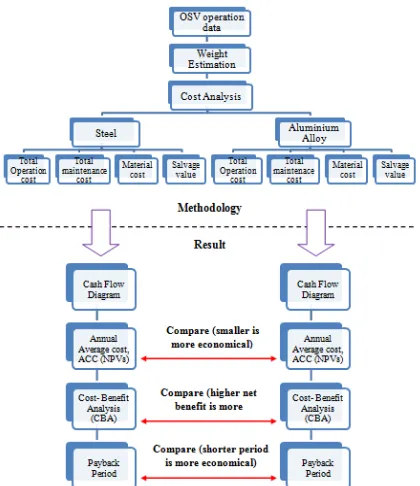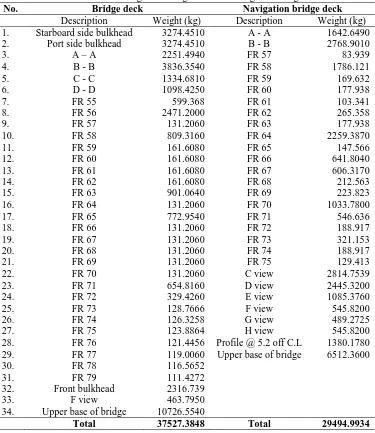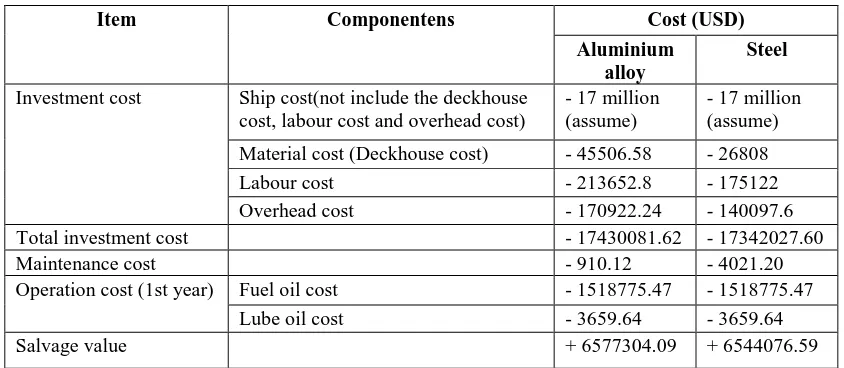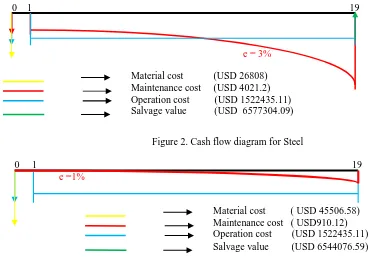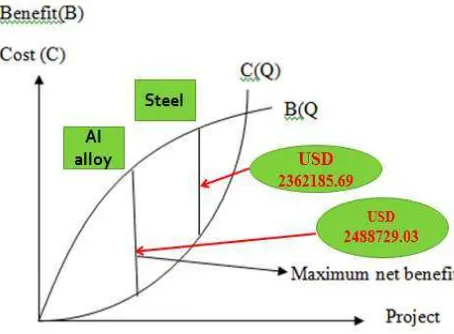IJNA-Vol. 1, No.1 June 2013 37
TECHNO-ECONOMIC STUDY OF ALUMINIUM ALLOY AND STEEL AS MATERIALS
FOR DECKHOUSES OF OFFSHORE SUPPORT VESSELS
Ferry M
1., A.M. Muzathik
2, Chan M.Y
1., K.B. Samo
1and C.W.M. Noor
11
Department of Maritime Technology, Universiti Malaysia Terengganu, Malaysia
2
Institute of Technology, University of Moratuwa, Katubedda, Sri Lanka.
* Corresponding Author e-mail: [email protected]; [email protected] ABSTRACT
Aluminium alloy is a relatively more expensive material than steel although its weight is one-third of the steel. Thus the use of steel as a structure adds additional weight by 60%; and when used as deckhouses would raise the GM and scarifying the stability of the offshore support vessel. This paper reviews the merit and demerit of Aluminium alloy and steel focusing on fabrication and assembly, and maintainability cost typical of a 60.0m offshore support vessel operating between Kemaman port and offshore oil rigs in the South China Sea. Mathematical equation was used to calculate the weight of the materials used to construct the deckhouses. Also, net present value and payback period calculations were performed to indicate the economic benefit between the two materials. The initial construction cost for Aluminium and Steel are USD 45506 and USD 6808 respectively involving 23.5 metric ton for Aluminium and 67.0 metric tons for steel. In term of investment, offshore support vessels using Aluminium have shorter payback period of 7.9 years and 8.4 years for steel inclusive of the costs of maintenance and operation. This exercise indicates Aluminium alloy is more economical than steel as construction material for deckhouse of offshore support vessel due to its light weight, lower maintenance and increase earning capacity (more cargo).
Keywords: Aluminum alloy, cost-benefit analysis, deckhouse, offshore support vessel, payback period
NOMENCLATURE IRR Internal rate of return
LOA Length overall market in Asia Pacific will continue to grow, driven by deepwater exploration and production activities. The
Offshore Support Vessels undertake production support, diving support, supply duties for personnel and materials, anchor handling, towing, mooring, rig moving, emergency response or rescue and fire fighting operations.
IJNA-Vol. 1, No.1 June 2013 38 time to intergranular corrosion and stress-corrosion
cracking, particularly when subjected to higher service temperatures on exposed decks [5]. Besiedes that, most aluminium alloys require low maintenance because of their good corrosion resistance. Therefore, aluminium is an excellent candidate for all applications where the benefit of freedom from initial protection and maintenance yields a commercial benefit. Aluminium is lighter than mild steel (approximate weight: Aluminium 2.723 ton/m³, Mild steel 7.84 ton/m³) and with an Aluminium structure it has been suggested that up to 60 per cent of the weight of a steel structure may be saved. Aluminium alloy also has excellent strength to weight ratio making it ideal for use in situations where high strength and low weight are required [6]. The properties required of a good shipbuilding steel is reasonable cost [4]. The use of the Aluminium alloy was higher initial cost, this have been estimated at 8 to 10 times the price of the steel on a tonnage basic [7]. Aluminium alloy was a more expensive material than most alternative structural materials. Cost was major consideration when decide to build deckhouse on offshore support vessel. And weight of the steel was heavier than Aluminium alloy. The weight of steel causes deckhouse not suitable to build on the offshore support vessel. Aluminium alloy was about one-third the weight of steel for an equivalent volume of material. The use of steel in a structure can result in addition of 60% of the weight of an equivalent aluminium alloy structure. This addition in weight, particularly in the upper regions of the structure, can lower the stability of the ship.
The study was aim to determined which material is more suitable to build the deckhouse on offshore support vessel. For this purpose three parametres were considered in this study. First, to identify weight difference between using Aluminium alloy and Steel for deckhouse and that cause this ship gains more comparison of different design options. A compound interest rate is used to determine the ‘present’ value of money to be spent in later years. The net present value (NPV) must be positive if an option is acceptable. The task of the ship builder is to evaluate the various
options in economic terms to see which gives the best overall result, recognizing both cost and operational performance.
2. METHODOLOGY
One excisting offshore support vessel was used in this study. Figure 1 is shows the methods used to determined the best material for deckhouse construction. Interview method also used to get more data and information about deckhouse from the shipyard. Mathematical models and equations were used to compute the weight and cost difference between using aluminium alloy and steel for deckhouse. Net present value, cost-benefit analysis (CBA), and payback period were used to analyse the fersibility of the desigen obtions in this study further namely.
Figure 1. Methodology Flow Chart
IJNA-Vol. 1, No.1 June 2013 37 Table 1. Principal Dimension for Offshore Support Vessel
Length overall 60.00m Main Engine: 2714bhp ×2 Length waterline 58.74m Main generator: 260kW ×2
Beam 16.00m Auxiliary Generator: 99kW
Depth 6.00m Deck space: 390m² (Approx.)
Draft 5.10m Deck loading: 5 ton/m²
DWT 1650ton Speed: 13.0knots
In this study the weight of deckhouse was taken from bridge deck and navigation bridge deck. The construction of deckhouse was form by steel frames,
bracket, and plate. The total weight calculation for bridge deck and navigation bridge deck is given in Table 2.
Table 2. The total weight for bridge deck and navigation bridge deck
No. Bridge deck Navigation bridge deck
Description Weight (kg) Description Weight (kg)
1. Starboard side bulkhead 3274.4510 A - A 1642.6490
2. Port side bulkhead 3274.4510 B - B 2768.9010
3. A – A 2251.4940 FR 57 83.939
4. B - B 3836.3540 FR 58 1786.121
5. C - C 1334.6810 FR 59 169.632
6. D - D 1098.4250 FR 60 177.938
7. FR 55 599.368 FR 61 103.341
8. FR 56 2471.2000 FR 62 265.358
9. FR 57 131.2060 FR 63 177.938
10. FR 58 809.3160 FR 64 2259.3870
11. FR 59 161.6080 FR 65 147.566
12. FR 60 161.6080 FR 66 641.8040
13. FR 61 161.6080 FR 67 606.3170
14. FR 62 161.6080 FR 68 212.563
15. FR 63 901.0640 FR 69 223.823
16. FR 64 131.2060 FR 70 1033.7800
17. FR 65 772.9540 FR 71 546.636
18. FR 66 131.2060 FR 72 188.917
19. FR 67 131.2060 FR 73 321.153
20. FR 68 131.2060 FR 74 188.917
21. FR 69 131.2060 FR 75 129.413
22. FR 70 131.2060 C view 2814.7539
23. FR 71 654.8160 D view 2445.3200
24. FR 72 329.4260 E view 1085.3760
25. FR 73 128.7666 F view 545.8200
26. FR 74 126.3258 G view 489.2725
27. FR 75 123.8864 H view 545.8200
28. FR 76 121.4456 Profile @ 5.2 off C.L 1380.1780
29. FR 77 119.0060 Upper base of bridge 6512.3600
30. FR 78 116.5652
31. FR 79 111.4272
32. Front bulkhead 2316.739
33. F view 463.7950
34. Upper base of bridge 10726.5540
Total 37527.3848 Total 29494.9934
2.1 STEEL DECKHOUSE
The ship has been builded mostly using grade A ABS steel. Density of grade A ABS steel is 7850 kg/m³.
IJNA-Vol. 1, No.1 June 2013 38 2.2 ALUMINIUM DECKHOUSE
The 5083 grade of Aluminium alloy is mostly used for ship construction and density of 5083 grade of Aluminium alloy is 2660 kg/m³. According to Loscombe [8] Aluminium alloy is exhibing 65% of the total weight of steel version. Therefore,
Total weight of deckhouse (Aluminium alloy) = Total weight of deckhouse (steel) × 35% = 67.02 ton × 0.35 = 23.457 tonnes
The weight of deckhouse using aluminium alloy is 23.457 tonnes whereas the weight of deckhouse using steel is 67.02 tonnes. Net weight gain of the ship using Aluminium alloy deckhouse is 43.563 tonnes. Therefore, the ship using Aluminium alloy deckhouse can carry more cargo compared with using steel deckhouse.
2.3 COST
The investment cost, material cost, labour cost, maintenance cost and overhead cost of offshore support vessel were estimated based on market prices. The labour cost of Aluminium alloy ship is higher because Aluminium alloy welding needed special skill workers. The price of aluminium alloy was USD 1940 per ton whereas price of steel was USD 400 per ton. Overhead costs include a wide variety of costs incurred in the
operation of the shipyard which are not directly chargeable to particular ship contracts. They include such items as interests on bank loans, rates and taxes, insurance, electricity, telephone and postage and others. The overhead cost is normally 80% of the labour cost [9]. The maintenance cost is cost for maintenance and repair of the ship. In this study, maintenannce cost for steel was considered as 15% of total material cost per year. In addition, the total maintenance cost of Steel was assumed increasing 3% each year. Meanwhile, maintenannce cost for Aluminium alloy was 2% of total material cost per the ship. Salvage value is the return cost when sell the ship. The salvage value depends on the market. It was assumed that the salvage value of the offshore support vessel is decreasing by 5% each year. The service life of the ship was considered as 20 years. The estimated cost componentens and overall cost are given in Table 3.
Table 3. Cost estimation
Item Componentens Cost (USD)
Aluminium alloy
Steel
Investment cost Ship cost(not include the deckhouse cost, labour cost and overhead cost)
- 17 million (assume)
- 17 million (assume) Material cost (Deckhouse cost) - 45506.58 - 26808
Labour cost - 213652.8 - 175122
Overhead cost - 170922.24 - 140097.6
Total investment cost - 17430081.62 - 17342027.60
Maintenance cost - 910.12 - 4021.20
Operation cost (1st year) Fuel oil cost - 1518775.47 - 1518775.47
Lube oil cost - 3659.64 - 3659.64
Salvage value + 6577304.09 + 6544076.59
Note: + debit (profit), - credit (expenditure)
2.4 INCOME OF SHIP
The following parameters were assumed for the income calculation of the ship. For a trip between port and platform 4 days are needed include loading and
IJNA-Vol. 1, No.1 June 2013 39 Income per year of deckhouse using Steel = USD
0.35 per ton /mile × 1200 tonnes 124.3 miles × (300/4) = USD 3915450
Net gain weight for AL deckhouse = 67.02 ton - 23.457 ton = 43.563 ton
Income per year of using Aluminium = USD 0.35 per/miles × (1200 + 43.563) ton 124.3miles × (300/4) = USD 4057580.84
3. RESULT AND DISCUSSION
3.1 CASH FLOW DIAGRAM OF STEEL AND ALUMINIUM DECKHOUSES
Figures 2 and 3 show the cash flow diagrams for steel and Aluminium alloy deckhouse ships respectivly. The positive direction shows the profit and negative direction shows the expenditure.
0 1 19
e = 3% Material cost (USD 26808) Maintenance cost (USD 4021.2) Operation cost (USD 1522435.11) Salvage value (USD 6577304.09)
Figure 2. Cash flow diagram for Steel
0 1 19 e =1%
Material cost ( USD 45506.58) Maintenance cost ( USD910.12) Operation cost (USD 1522435.11) Salvage value (USD 6544076.59)
Figure 3. Cash flow diagram for Aluminium alloy
3.2 ANNUAL AVERAGE COST
To calculate the profit that the ship gains, it is usual to apply discounted cash flow methods to establish a net present value for the comparison of different design options. A compound interest rate is used to determine the ‘present’ value of money to be spent in later years. The net present value (NPV) must be positive if an option is acceptable. The differences in Annual Average Cost (AAC) between Steel and Aluminium alloy deckhouse ship operation was used to analyzed the fesibility. The following equations were used to calculate AAC.
NPV (Net Present Value) = - PV (maintenance cost) – PV (operation cost) + PV (salvage value) (1) PV (maintenance cost) = D (2)
PV (operation cost) = p (3) PV (Salvage Value) = P (4)
ACC (NPV) = NPV (5)
wher PV is present value, D is maitenance cost for 1st year, e is % of maintenance cost each year, i is interest rate, n is life time in years, p is operation cost and P is salvage value.
AAC (NPV) of deckhouse using Steel: = USD 39429459.27
= USD2411611.54
AAC (NPV) of Aluminium deckhouse : = USD 39277476.31
= USD 2402315.85
IJNA-Vol. 1, No.1 June 2013 40 3.3 COST BENEFIT ANALYSIS
A cost benefit analysis finds, quantifies, and adds all the positive factors. These were the benefits. Then it
identifies, quantifies, and subtracts all the negatives, the costs. The difference between the two indicates whether the planned action is advisable. Overall cost-benefit analysis is presente in Table 4.
Table 4. Overall cost-benefit analysis
Description Aluminium alloy (USD) Steel (USD)
Income Investment per year 4057580.84 3915450.00
Total benefit 4057580.84 3915450.00
Maintenance cost 910.12 4021.20
Construction cost for deckhouse 45506.58 26808.00
Operation cost per year 1522435.11 1522435.11
Total cost 1568851.81 1553264.31
Net benefit 2488729.03 2362185.69
Comparison of cost-benefit analysis of Aluminium alloy and Steel deckhouse ship is given in Figure 4. The net benefit of the Aluminium alloy deukhouse ship is higher than net benefit of the Steel deukhouse ship and difference between them is USD 126543.34. The results shown that the Aluminium alloy deckhouse ship
has maximum net benefit. If we used steel for deckhouse, the lost of the profit wsa USD 126543.34 compared with Aluminium alloy deckhouse. Therefore, deckhouse using Aluminium alloy is more profitable for offshore support vessel.
Figure 4. Comparison of cost-benefit analysis of Aluminium alloy and Steel deckhouse ship
3.4 PAYBACK OERIOD
Payback period is the amount of time required to recover the initial investment in a project.
Cash inflow of deckhouse using Steel:
Income - maintenance cost - operation cost - crew cost USD 3915450 - USD 4021.2 - USD1522435.11 - USD 332268
USD 2056725.69
Payback Period: = 8.4319 years = 8 years 5 months
Cash inflow of deckhouse using Aluminium :
Income - maintenance cost - operation cost - crew cost USD 4057580.84 - USD910.12 - USD1522435.11 - USD 332268
USD 2201967.61 Payback Period:
= 7.9157 years = 7 years 11 months
IJNA-Vol. 1, No.1 June 2013 41
4. CONCLUSION AND
RECOMMENDATION
The research results are conforming that the Aluminium alloy is more suitable for building deckhouse on offshore support vessel since it has lighter weight than steel, permit the vessel to carry more cargo, less annual average cost, maximum net benefit and shorter payback period. Therefore, Aluminium alloy deckhouse ship is more economical. Further, the performance Of the deckhouse using others materials such as composite (lightweight and better dimensional stability than steel elements) must be studied in future and a prototype of OSV develeped to evaluate the performance.
5. REFERENCES
1. John B. O’Brien, Peter M. Palermo, Capt James R. Wilkins. 1975. Today’s Navy- Echoes of the Past-Sounds of the
Future. Naval Ship Engineering Center, Hyattsville. 2. Sielski, R A. 1987. The history of Aluminium as a deckhouse material, Journal article; Paper presented at ASNE Day.
3. Robert A. Sielski. 2007. Research Needs in Aluminum Structure.Naval Architect—Structures,Indio, California. USA
4. D.A.Taylor. 1980. Merchant ship construction. Butterworth &Co.(Publishers) Ltd. Pages 25, 26, 28. USA.
5. Stephen F.Polard, Boatbuilding with aluminium. 1993. International Marine Camden, Marine, pg 22. Capalex. 2006.
6. D.J. Eyres M.Sc. 2007. Aluminium alloy Ship Construction (Sixth Edition), Pages 50-54.
7. David J. Eyres. 1994. Ship construction. Elsevier Butterworth-Heinemann.
8. A . R. Loscombe. 1987. An exploratory study of alternative structural materials for small swath craft Ship Science. Report No. 34.
